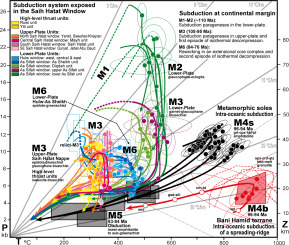当前位置:
X-MOL 学术
›
Gondwana Res.
›
论文详情
Our official English website, www.x-mol.net, welcomes your
feedback! (Note: you will need to create a separate account there.)
Metamorphic response within different subduction–obduction settings preserved on the NE Arabian margin
Gondwana Research ( IF 7.2 ) Pub Date : 2020-07-01 , DOI: 10.1016/j.gr.2020.02.002 Ben Goscombe , David A. Foster , David Gray , David Kelsey , Ben Wade
Gondwana Research ( IF 7.2 ) Pub Date : 2020-07-01 , DOI: 10.1016/j.gr.2020.02.002 Ben Goscombe , David A. Foster , David Gray , David Kelsey , Ben Wade

|
Abstract Metamorphic rocks form a minor component of the NE Arabian margin in Oman and the United Arab Emirates (UAE). Conditions span almost the entire range of crustal metamorphism from very high-P/low-T eclogite and blueschist to high-P/moderate-T epidote- to upper-amphibolite and low-P/high-T granulite facies. The NE Arabian margin experienced at least six metamorphic events, each characterized by distinct peak metamorphic temperature, depth of burial, average thermal gradient and timing. Synthesis of the available metamorphic data defines five different tectonic settings that evolved during the middle Cretaceous: [1] The Saih Hatat window exposes former continental margin crust that was buried and metamorphosed in a SW-dipping subduction system. Lower-plate units in the window include relict oceanic crust with eclogite (M1–M2) parageneses that recrystallized at pressures of ~14–23 kbar under very low thermal gradients of 7–10 °C/km. Peak metamorphism occurred at ~110 Ma. Peak assemblages were overprinted by garnet–glaucophane-blueschist foliations (M3) at about ~104–94 Ma that formed at ~10–15 kbar and 10–15 °C/km during the first-stage of isothermal exhumation. [2] Metamorphic soles in the footwall of the Semail ophiolite experienced a two-stage history of deep burial and peak metamorphism at ~96–94 Ma, followed by retrogression during obduction onto the continental margin between ~93 and 84 Ma. Peak metamorphic garnet–clinopyroxene–hornblende–plagioclase assemblages (M4s), exposed at highest structural levels, formed at 743 ± 13 °C and 10.7 ± 0.4 kbar, indicating Barrovian thermal regimes of 20.0 ± 2.2 °C/km. Burial of seafloor sediments and oceanic crust to ~38 km depth, was attained within a short-lived, NE-dipping intra-oceanic subduction system. The relatively high average thermal gradient during the peak of metamorphism was the result of heating after subcretion onto the base of hanging-wall oceanic lithosphere. [3] The Bani Hamid terrane consists of seafloor cherts and calcareous turbidites, metamorphosed to low-P/high-T granulite condition at ~96–94 Ma. Diagnostic assemblages (M4b) such as orthopyroxene–cordierite–quartz–plagioclase and orthopyroxene–sapphirine–hercynite–quartz–plagioclase, formed at conditions averaging ~915 ± 35 °C, ~6.1 ± 0.9 kbar and ~42.9 ± 6.5 °C/km. The elevated average thermal gradient, combined with significant depths of burial, is anomalous for typical oceanic settings. This suggests that these sea-floor sediments were buried to ~22 km depths within the intra-oceanic subduction system, accreted onto the hanging-wall, and metamorphosed at high-T during subduction of a recently active spreading ridge. [4] A plausible plate tectonic arrangement that can account for the different metamorphic elements on the Arabian margin is one composed of divergent subduction systems: a relatively long-lived SW-dipping subduction zone at the continental margin, and a short-lived, NE-dipping intra-oceanic subduction system. Consumption of the intervening oceanic crust led to obduction of the Semail ophiolite and accreted metamorphic soles from the upper-plate of the floundered outboard subduction system. SW-directed obduction was initiated between 93.7 and 93.2 Ma and continued until ~84 Ma, producing lower-amphibolite to sub-greenschist facies retrograde fabrics in the metamorphic soles (M5) and sub-metamorphic melange in the footwall. [5] The lower-plate of the Saih Hatat window was reworked by top-to-NE extensional shear at epidote-greenschist facies grades (M6) between ~84 and 76 Ma. Crustal-scale structures were reactivated as extensional detachments that telescoped the continental margin, leading to isothermal decompression and development of an asymmetric core complex that segmented the Semail ophiolite and formed the Saih Hatat domal window.
中文翻译:

在 NE 阿拉伯边缘保留的不同俯冲-外展环境中的变质反应
摘要 变质岩是阿曼和阿拉伯联合酋长国 (UAE) 东北部阿拉伯边缘的次要组成部分。条件几乎涵盖了从极高 P/低 T 榴辉岩和蓝片岩到高 P/中 T 绿帘石到上角闪岩和低 P/高 T 麻粒岩相的整个地壳变质作用范围。东北阿拉伯边缘经历了至少 6 次变质事件,每个事件的特点是不同的峰值变质温度、埋藏深度、平均温度梯度和时间。现有变质数据的综合定义了白垩纪中期演化的五种不同构造环境: [1] Saih Hatat 窗口暴露了在西南倾斜俯冲系统中被掩埋和变质的前大陆边缘地壳。窗口中的下板块单元包括带有榴辉岩 (M1-M2) 共生岩的残存洋壳,它们在约 14-23 kbar 的压力下在 7-10 °C/km 的极低热梯度下重结晶。峰值变质发生在~110 Ma。在等温折返的第一阶段,在约 10-15 kbar 和 10-15 °C/km 下形成的石榴石-蓝闪石-蓝片岩叶理(M3)在约~104-94 Ma 处叠印了峰值组合。[2] Semail蛇绿岩下盘的变质底部经历了~96-94 Ma的深埋和峰值变质作用的两个阶段历史,随后在~93~84 Ma之间在外倾到大陆边缘期间发生倒退。峰值变质石榴石-斜辉石-角闪石-斜长石组合 (M4s),暴露于最高结构水平,形成于 743 ± 13 °C 和 10.7 ± 0.4 kbar,表明巴罗维亚热状态为 20.0 ± 2.2 °C/km。海底沉积物和大洋地壳的埋藏深度约为 38 公里,是在一个短暂的、向东北倾斜的洋内俯冲系统中实现的。变质作用高峰期相对较高的平均温度梯度是下沉到上盘大洋岩石圈底部后加热的结果。[3] Bani Hamid 地体由海底燧石和钙质浊积岩组成,在~96-94 Ma 变质为低 P/高 T 麻粒岩条件。诊断组合(M4b),如斜辉石-堇青石-石英-斜长石和斜辉石-蓝宝石-海长石-石英-斜长石,形成于平均~915±35°C、~6.1±0.9kbar和~42.9±6.5°C的条件下. 升高的平均温度梯度,加上显着的埋藏深度,对于典型的海洋环境来说是异常的。这表明这些海底沉积物被埋在洋内俯冲系统内约 22 公里的深度,吸积到上壁上,并在最近活跃的扩张脊俯冲期间在高 T 处变质。[4] 一个可以解释阿拉伯边缘不同变质元素的似是而非的板块构造排列是由不同的俯冲系统组成的:大陆边缘相对长寿命的西南倾斜俯冲带,和短寿命的东北俯冲带-浸入洋内俯冲系统。中间大洋地壳的消耗导致塞迈尔蛇绿岩和从陷入困境的外侧俯冲系统的上板吸出的变质底部。SW 定向诱导发生在 93.7 和 93 之间。2 Ma 并持续到~84 Ma,在变质底部 (M5) 和下盘中的亚变质混杂岩中产生低角闪石到亚绿片岩相逆行织物。[5] Saih Hatat 窗口的下板在绿帘石-绿片岩相等级 (M6) 约 84 到 76 Ma 之间通过从顶部到东北的拉伸剪切重新加工。地壳尺度结构被重新激活为扩张大陆边缘的伸展脱离,导致等温减压和不对称核心复合体的发展,该复合体将 Semail 蛇绿岩分割并形成 Saih Hatat 圆顶窗。[5] Saih Hatat 窗口的下板在绿帘石-绿片岩相等级 (M6) 约 84 到 76 Ma 之间通过从顶部到东北的拉伸剪切重新加工。地壳尺度结构被重新激活为扩张大陆边缘的伸展脱离,导致等温减压和不对称核心复合体的发展,该复合体将 Semail 蛇绿岩分割并形成 Saih Hatat 圆顶窗。[5] Saih Hatat 窗口的下板在绿帘石-绿片岩相等级 (M6) 约 84 到 76 Ma 之间通过从顶部到东北的拉伸剪切重新加工。地壳尺度结构被重新激活为扩张大陆边缘的伸展脱离,导致等温减压和不对称核心复合体的发展,该复合体将 Semail 蛇绿岩分割并形成 Saih Hatat 圆顶窗。
更新日期:2020-07-01
中文翻译:

在 NE 阿拉伯边缘保留的不同俯冲-外展环境中的变质反应
摘要 变质岩是阿曼和阿拉伯联合酋长国 (UAE) 东北部阿拉伯边缘的次要组成部分。条件几乎涵盖了从极高 P/低 T 榴辉岩和蓝片岩到高 P/中 T 绿帘石到上角闪岩和低 P/高 T 麻粒岩相的整个地壳变质作用范围。东北阿拉伯边缘经历了至少 6 次变质事件,每个事件的特点是不同的峰值变质温度、埋藏深度、平均温度梯度和时间。现有变质数据的综合定义了白垩纪中期演化的五种不同构造环境: [1] Saih Hatat 窗口暴露了在西南倾斜俯冲系统中被掩埋和变质的前大陆边缘地壳。窗口中的下板块单元包括带有榴辉岩 (M1-M2) 共生岩的残存洋壳,它们在约 14-23 kbar 的压力下在 7-10 °C/km 的极低热梯度下重结晶。峰值变质发生在~110 Ma。在等温折返的第一阶段,在约 10-15 kbar 和 10-15 °C/km 下形成的石榴石-蓝闪石-蓝片岩叶理(M3)在约~104-94 Ma 处叠印了峰值组合。[2] Semail蛇绿岩下盘的变质底部经历了~96-94 Ma的深埋和峰值变质作用的两个阶段历史,随后在~93~84 Ma之间在外倾到大陆边缘期间发生倒退。峰值变质石榴石-斜辉石-角闪石-斜长石组合 (M4s),暴露于最高结构水平,形成于 743 ± 13 °C 和 10.7 ± 0.4 kbar,表明巴罗维亚热状态为 20.0 ± 2.2 °C/km。海底沉积物和大洋地壳的埋藏深度约为 38 公里,是在一个短暂的、向东北倾斜的洋内俯冲系统中实现的。变质作用高峰期相对较高的平均温度梯度是下沉到上盘大洋岩石圈底部后加热的结果。[3] Bani Hamid 地体由海底燧石和钙质浊积岩组成,在~96-94 Ma 变质为低 P/高 T 麻粒岩条件。诊断组合(M4b),如斜辉石-堇青石-石英-斜长石和斜辉石-蓝宝石-海长石-石英-斜长石,形成于平均~915±35°C、~6.1±0.9kbar和~42.9±6.5°C的条件下. 升高的平均温度梯度,加上显着的埋藏深度,对于典型的海洋环境来说是异常的。这表明这些海底沉积物被埋在洋内俯冲系统内约 22 公里的深度,吸积到上壁上,并在最近活跃的扩张脊俯冲期间在高 T 处变质。[4] 一个可以解释阿拉伯边缘不同变质元素的似是而非的板块构造排列是由不同的俯冲系统组成的:大陆边缘相对长寿命的西南倾斜俯冲带,和短寿命的东北俯冲带-浸入洋内俯冲系统。中间大洋地壳的消耗导致塞迈尔蛇绿岩和从陷入困境的外侧俯冲系统的上板吸出的变质底部。SW 定向诱导发生在 93.7 和 93 之间。2 Ma 并持续到~84 Ma,在变质底部 (M5) 和下盘中的亚变质混杂岩中产生低角闪石到亚绿片岩相逆行织物。[5] Saih Hatat 窗口的下板在绿帘石-绿片岩相等级 (M6) 约 84 到 76 Ma 之间通过从顶部到东北的拉伸剪切重新加工。地壳尺度结构被重新激活为扩张大陆边缘的伸展脱离,导致等温减压和不对称核心复合体的发展,该复合体将 Semail 蛇绿岩分割并形成 Saih Hatat 圆顶窗。[5] Saih Hatat 窗口的下板在绿帘石-绿片岩相等级 (M6) 约 84 到 76 Ma 之间通过从顶部到东北的拉伸剪切重新加工。地壳尺度结构被重新激活为扩张大陆边缘的伸展脱离,导致等温减压和不对称核心复合体的发展,该复合体将 Semail 蛇绿岩分割并形成 Saih Hatat 圆顶窗。[5] Saih Hatat 窗口的下板在绿帘石-绿片岩相等级 (M6) 约 84 到 76 Ma 之间通过从顶部到东北的拉伸剪切重新加工。地壳尺度结构被重新激活为扩张大陆边缘的伸展脱离,导致等温减压和不对称核心复合体的发展,该复合体将 Semail 蛇绿岩分割并形成 Saih Hatat 圆顶窗。











































 京公网安备 11010802027423号
京公网安备 11010802027423号